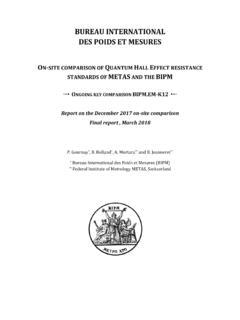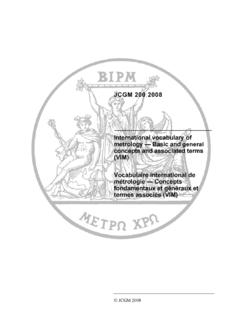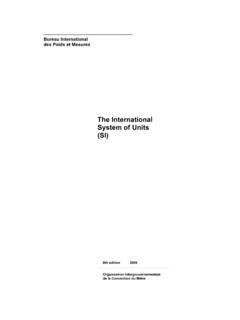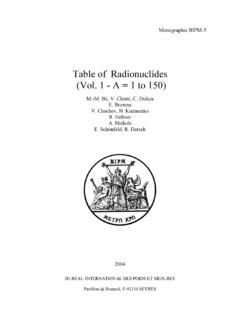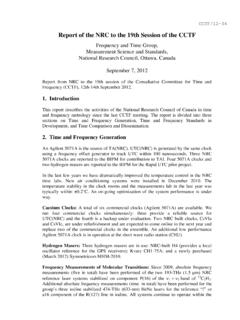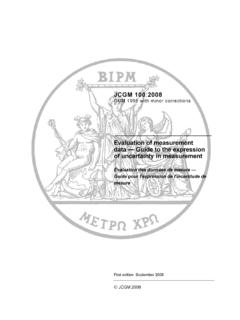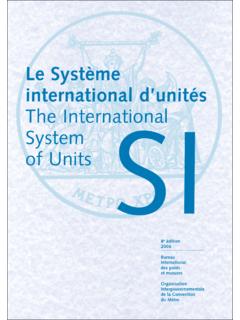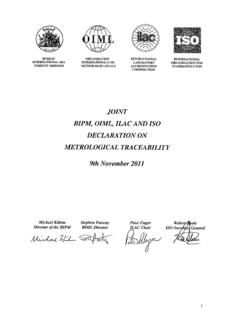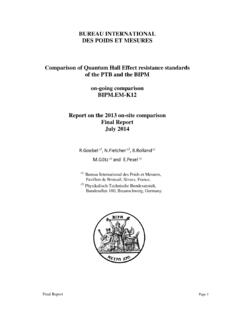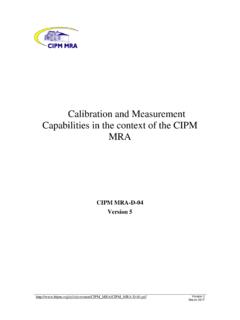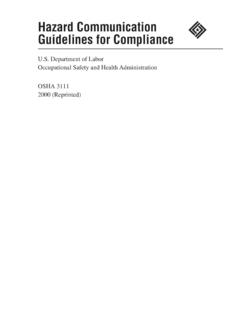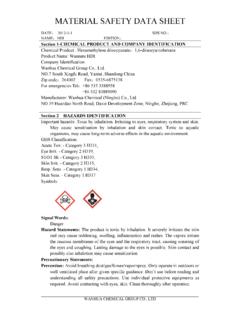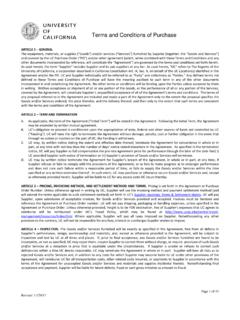Transcription of SI maq E - BIPM
1 A concise summary of the international system of Units, the The Bureau international des Poids et Mesures, the BIPM, was established by Article 1 of the Convention du M tre, on 20 May 1875, and is charged with providing the basis for a single, coherent system of measurements to be used throughout the world. The decimal metric system , dating from the time of the French Revolution, was based on the metre and the kilogram. Under the terms of the 1875 Convention, new inter- national prototypes of the metre and kilogram were made and formally adopted by the first Conf rence G n rale des Poids et Mesures (CGPM) in 1889. Over time this system developed, so that it now includes seven base units. In 1960 it was decided at the 11th CGPM that it should be called the Syst me international d Unit s, the SI (in English: the international system of Units).
2 The SI is not static but evolves to match the world s increas-ingly demanding requirements for measure-ments at all levels of precision and in all areas of science, technology, and human endeavour. This document is a summary of the SI Brochure, a publication of the BIPM which is a statement of the current status of the seven base units of the SI, listed in Table 1, provide the reference used to define all the meas-urement units of the international system . As science advances, and methods of measurement are refined, their definitions have to be revised. The more accurate the measurements, the greater the care required in the realization of the units of international prototype of the kilogram, K , the only remaining artefact used to define a base unit of the is the science of measurement, embracing all measurements, made at a known level of uncertainty, in any field of human 1 The seven base units of the SIQuantity Unit, symbol: definition of unitlengthmetre, m: The metre is the length of the path travelled by light in vacuum during a time interval of 1/299 792 458 of a follows that the speed of light in vacuum, c0 , is 299 792 458 m/s , kg: The kilogram is the unit of mass.
3 It is equal to the mass of the international prototype of the follows that the mass of the international prototype of the kilogram, m(K ), is always 1 kg , s: The second is the duration of 9 192 631 770 periods of the radiation corresponding to the transition between the two hyperfine levels of the ground state of the caesium 133 follows that the hyperfine splitting in the ground state of the caesium 133 atom, v (hfs Cs), is 9 192 631 770 Hz currentampere, A: The ampere is that constant current which, if maintained in two straight parallel conductors of infinite length, of negligible circular cross-section, and placed 1 metre apart in vacuum, would produce between these conductors a force equal to 2 10 7 newton per metre of follows that the magnetic constant, 0 , also known as the permeability of free space is 4 10 7 H/m temperaturekelvin, K: The kelvin, unit of thermodynamic temperature, is the fraction 1 of the thermodynamic temperature of the triple point of follows that the thermodynamic temperature of the triple point of water, Ttpw , is K of substancemole, mol: 1.
4 The mole is the amount of substance of a system which contains as many elementary entities as there are atoms in kilogram of carbon 12. 2. When the mole is used, the elementary entities must be specified and may be atoms, molecules, ions, electrons, other particles, or specified groups of such follows that the molar mass of carbon 12, M(12C), is 12 g/mol intensitycandela, cd: The candela is the luminous intensity, in a given direction, of a source that emits monochromatic radiation of frequency 540 1012 hertz and that has a radiant intensity in that direction of 1/683 watt per follows that the spectral luminous efficacy, K, for monochromatic radiation of frequency 540 1012 Hz is 683 lm/W seven base quantities corresponding to the seven base units are length, mass, time, electric current, thermodynamic temperature, amount of substance, and luminous intensity.
5 The base quantities and base units are listed, with their symbols, in Table other quantities are described as derived quantities, and are measured using derived units, which are defined as products of powers of the base units. Examples of derived quantities and units are listed in Table 3. Note that refractive index and relative permeability are examples of dimensionless quantities, for which the SI unit is the number one, 1, although this unit is not derived units are given a special name, these being simply a compact form for the expression of combinations of base units that are used frequently. Thus, for example, the joule, symbol J, is by definition equal to m2 kg s 2. There are 22 special names for units approved for use in the SI at present, and these are listed in Table the hertz and the becquerel are both equal to the reciprocal second, the hertz is only used for cyclic phenomena, and the becquerel for stochastic processes in radioactive unit of Celsius temperature is the degree Celsius, oC, which is equal in magnitude to the kelvin, K, the unit of thermodynamic temperature.
6 The quantity Celsius temperature t is related to thermodynamic temperature T by the equation t/oC = T/K 2 Base quantities and base units used in the SIBase quantitySymbolBase unitSymbollengthl, h, r, xmetremmassmkilogramkgtime, durationtsecondselectric currentI, iampereAthermodynamic temperatureTkelvinKamount of substancenmolemolluminous intensityIvcandelacdTable 3 Examples of derived quantities and unitsDerived quantitySymbolDerived unitSymbolareaAsquare metrem2volumeVcubic metrem3speed, velocityvmetre per secondm/saccelerationametre per second squaredm/s2wavenumber , ~vreciprocal metrem 1mass density kilogram per cubic metrekg/m3surface density Akilogram per square metrekg/m2specific volumevcubic metre per kilogramm3/kgcurrent densityjampere per square metreA/m2magnetic field strengthHampere per metreA/mconcentrationcmole per cubic metremol/m3mass concentration , kilogram per cubic metrekg/m3luminanceLvcandela per square metrecd/m2refractive indexnone1relative permeability rone1 Derived quantityName of derived unitSymbol for unitExpression in terms of other unitsplane angleradianradm/m = 1solid anglesteradiansrm2/m2 = 1frequencyhertzHzs 1forcenewtonNm kg s 2pressure, stresspascalPaN/m2 = m 1 kg s 2energy, work, amount of heatjouleJN m = m2 kg s 2power, radiant fluxwattWJ/s = m2 kg s 3electric charge.
7 Amount of electricitycoulombCs Aelectric potential differencevoltVW/A = m2 kg s 3A 1 capacitancefaradFC/V = m 2 kg 1 s4 A2electric resistanceohm V/A = m2 kg s 3 A 2electric conductancesiemensSA/V = m 2 kg 1 s3 A2magnetic fluxweberWbV s = m2 kg s 2 A 1magnetic flux densityteslaTWb/m2 = kg s 2 A 1inductancehenryHWb/A = m2 kg s 2 A 2 Celsius temperaturedegree CelsiusoCKluminous fluxlumenlmcd sr = cdilluminanceluxlxlm/m2 = m 2 cdactivity referred to a radionuclidebecquerelBqs 1absorbed dose, specific energy (imparted), kermagrayGyJ/kg = m2 s 2dose equivalent, ambient dose equivalentsievertSvJ/kg = m2 s 2catalytic activitykatalkats 1 molTable 4 Derived units with special names in the SIThe sievert is also used for the quantities directional dose equivalent and personal dose last four special names for units in Table 4 were adopted specifically to safeguard measurements related to human each quantity, there is only one SI unit (although it may often be expressed in different ways by using the special names).
8 However the same SI unit may be used to express the values of several different quantities (for example, the SI unit J/K may be used to express the value of both heat capacity and entropy). It is therefore important not to use the unit alone to specify the quantity. This applies both to scientific texts and also to meas-uring instruments ( an instrument read-out should indicate both the quantity concerned and the unit).Dimensionless quantities, also called quantities of dimension one, are usually defined as the ratio of two quantities of the same kind (for example, refractive index is the ratio of two speeds, and relative permittivity is the ratio of the permittivity of a dielectric medium to that of free space). Thus the unit of a dimensionless quantity is the ratio of two identical SI units, and is therefore always equal to one. However in expressing the values of dimensionless quantities the unit one, 1, is not multiples and sub-multiples of SI unitsA set of prefixes have been adopted for use with the SI units, in order to express the values of quantities that are either much larger than or much smaller than the SI unit used without any prefix.
9 The SI prefixes are listed in Table 5. They may be used with any of the base units and with any of the derived units with special the prefixes are used, the prefix name and the unit name are combined to form a single word, and similarly the prefix symbol and the unit symbol are written without any space to form a single symbol, which may itself be raised to any power. For example, we may write: kilometre, km; microvolt, V; femtosecond, fs; 50 V/cm = 50 V (10 2 m) 1 = 5000 the base units and derived units are used without any prefixes, the resulting set of units is described as being coherent. The use of a coherent set of units has technical advantages (see the SI Brochure). However the use of the prefixes is convenient because it avoids the need to use factors of 10n to express the values of very large or very small quantities. For example, the length of a chemical bond is more conveniently given in nano-metres, nm, than in metres, m, and the distance from London to Paris is more conveniently given in kilometres, km, than in metres, kilogram, kg, is an exception, because although it is a base unit the name already includes a prefix, for historical reasons.
10 Multiples and sub-multiples of the kilogram are written by combining prefixes with the gram: thus we write milligram, mg, not microkilogram, outside the SIThe SI is the only system of units that is universally recognized, so that it has a distinct advantage in establishing an international dialogue. Other units, non-SI units, are generally defined in terms of SI units. The use of the SI also simplifies the teaching of science. For all these reasons the use of SI units is recom-mended in all fields of science and some non-SI units are still widely used. A few, such as the minute, hour and day as units of time, will always be used because they are so deeply embedded in our culture. Others are used for historical reasons, to meet the needs of special interest groups, or because there is no convenient SI alternative. It will always remain the prerogative of a scientist to use the units that are considered to be best suited to the purpose.
